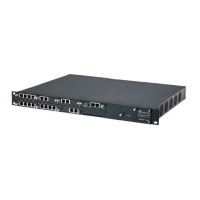Version 7.2 371 Mediant 800B Gateway & E-SBC
User's Manual 17. Control Network
Parameter Description
instead (and disable the Classify by Proxy Set feature), where the
rule is configured with not only the IP address, but also with SIP
message characteristics to increase the strictness of the
classification process (see Configuring Classification Rules on page
701).
The reason for preferring classification based on Proxy Set when the
IP address is unknown is that IP address forgery (commonly known
as IP spoofing) is more difficult than malicious SIP message
tampering and therefore, using a Classification rule without an IP
address offers a weaker form of security. When classification is
based on Proxy Set, the Classification table for the specific IP Group
is ignored.
If you have assigned the same Proxy Set to multiple IP Groups,
disable the parameter and instead, use Classification rules to classify
incoming SIP dialogs to these IP Groups. If the
the device is unable to correctly classify incoming INVITEs to their
appropriate IP Groups.
Classification by Proxy Set occurs only if classification based on the
device's registration database fails (i.e., the INVITE is not from a
registered user).
SBC Operation Mode
sbc-operation-mode
[IPGroup_SBCOperationM
ode]
Defines the device's operational mode for the IP Group.
[-1] Not Configured = (Default)
[0] B2BUA = Device operates as a back-to-
changing the call identifiers and headers between the inbound and
outbound legs.
[1] Call Stateful Proxy = Device operates as a Stateful Proxy, passing
the SIP message transparently between inbound and outbound legs.
In other words, the same SIP dialog identifiers (tags, Call-Id and
CSeq) occur on both legs (as long as no other configuration disrupts
the CSeq compatibleness).
[2] Microsoft Server = Operating mode for the One-Voice Resiliency
feature, whereby the device is deployed together with Skype for
Business-compatible IP Phones at small remote branch offices in a
Microsoft® Skype for Business™ environment.
For more information on B2BUA and Stateful Proxy modes, see B2BUA
and Stateful Proxy Operating Modes on page 660.
Note: If configured, the parameter overrides the 'SBC Operation Mode'
parameter in the SRDs table.
SBC Client Forking Mode
sbc-client-forking-mode
[IPGroup_EnableSBCClie
ntForking]
Defines call forking of INVITE messages to up to five separate SIP
outgoing legs for User-type IP Groups. This occurs if multiple contacts
are registered under the same AOR in the device's registration
database.
[0] Sequential = (Default) Sequentially sends the INVITE to each
contact. If there is no answer from the first contact, it sends the
INVITE to the second contact, and so on until a contact answers. If
no contact answers, the call fails or is routed to an alternative
destination, if configured.
[1] Parallel = Sends the INVITE simultaneously to all contacts. The
call is established with the first contact that answers.
[2] Sequential Available Only = Sequentially sends the INVITE only to
available contacts (i.e., not busy). If there is no answer from the first

